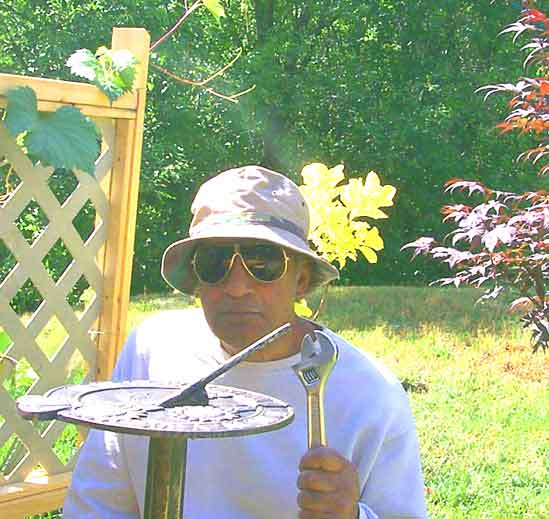
pineapple sky
2004~june
elms
marking time
flying in
rhubarb

Ken adjusts slow-running sundial...
|
 |
June 21, 2004
....the latest
marking time
My dad was always fascinated by clocks, and knew how to repair them. He always dreamed of having a real grandfather clock, and I was able to make this dream come true one year. Shipping a grandfather clock from Canada to Trinidad is not a mean feat.
I had the clock in my own home for a year, and it cured me of the notion I had hoarded that, like my father, I would like one of my own some day. The reason for this cure was that the clock, though strikingly beautiful, (pun intended), was not attuned to current lifestyles, which tend to favour automated systems. The clock's weights ran down every seven days, which sounds like a lot, but this is one way to find out it isn't. You need to remember to pull them up again. Otherwise, the clock stops and has to be reset (dong, dong, dong). This did not suit me.
Consequently, after due deliberation and cogitation and careful consideration of some twenty years, I recently decided to acquire a sun-dial instead, as I have always wanted one of those, too. After all, it is much cheaper, and is the ultimately self-supporting system - provided that the sun rises. No batteries, no electronics, no moving parts: my kind of machine. One might be late on rainy or snowy days, but people, especially if they are from Trinidad, often consider precipitation to be an understandable reason for being late anyway. Hey, it was precipitating, and I couldn't see the time on my sundial, you know?
About 3500 years ago, people in Egypt, where I believe it is very sunny, noticed that if they stuck a delicately tapered granite rod, (or "obelisk"), into the ground, in the course of the day, its shadow actually automatically revolved around it in circular fashion. They would have called this "clockwise", but clocks hadn't been invented yet. It's a good thing, too, that the Egyptians did not live in the southern hemisphere, otherwise "clockwise" today would have meant going the other way around. It gets very confusing, but really, it seems to me that sundial factories must have two reverse-design models, depending on the customer's home hemisphere; and if we ever move to Australia, we would have to leave our sundials behind.
Anyways (pl., sic, Cdn), I got this sundial, see, and meticulously oriented it to where I knew the north star hangs out, just over my ash tree and a tish (pre-metric unit of measurement) to the right. ("Oriented" to "north", that'll crack them up, tee-hee). Well, to my consternation, my sundial immediately began to run fast. In the middle of the day, it ran like hours slow. I was baffled. With the grandfather clock, you moved a little sliding weight up or down the pendulum to adjust the time, but with a sun-dial? Mine, like most everything else in the world, is Made in China (not Egypt), and came with no instructions. I began to worry - harbour a secret primal fear is more like it, you know how it is - that my gnomon might not be long enough.
Gnomon? It's the heigh-ho-up-she-rises little stalk that casts the shadow on a sundial. You could call it the shadow-stalk and be done, but it's much more erudite to call it a gnomon, gnisn't it? Unless you prefer obelisk.
Gnow, I'm not the type to drive around the neighbourhood and competitively ogle other people's gnoma. Gno man, gno way. I'm inclined to think that my sundial's dial was calibrated decoratively rather than empirically, and I will not use it to get to work or catch a plane.
(Helpful hint: Don't attempt to adjust your sundial at night. Torchlights, flashlights and patio lights just don't help with this endeavour. See pic attached of me valiantly setting out to adjust).
(Helpful hint II: If you prefer gnano-second accuracy, download an auto-synching app from http://www.worldtimeserver.com/. This will keep your computer synchronized with the atomic timeclock in sunny downtown Boulder, Colorado).
| |
|



